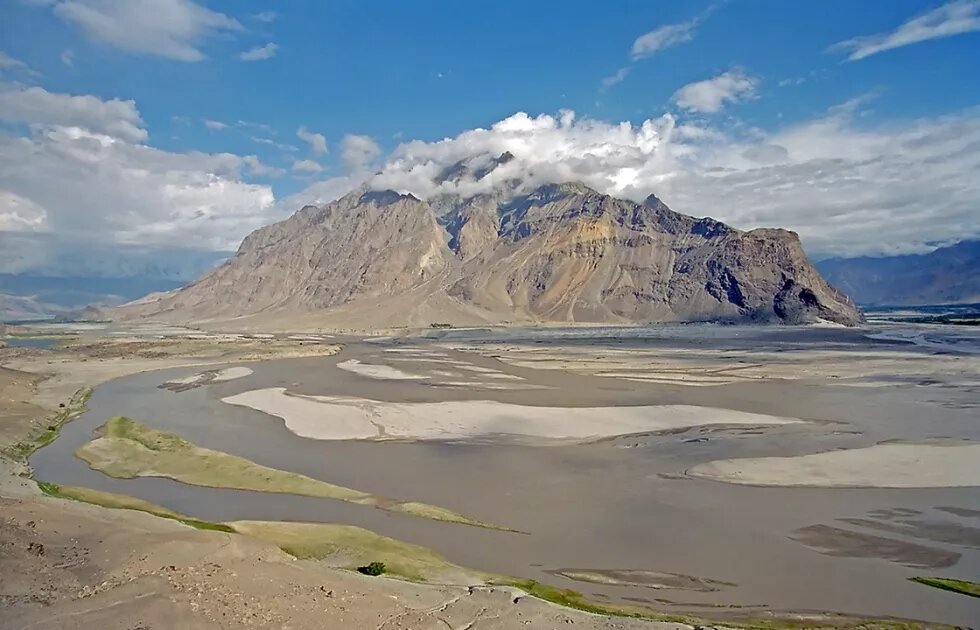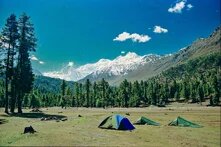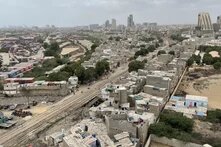The ‘Living Indus Initiative’ embarks on an outreach and advocacy that would lead to the acknowledgement of the Indus as a living body with a judicially acknowledged status.

It is said that before entering the sea
a river trembles with fear.
She looks back at the path she has travelled,
from the peaks of the mountains,
the long winding road crossing forests and villages.
And in front of her,
she sees an ocean so vast,
that to enter
there seems nothing more than to disappear forever.
But there is no other way.
The river cannot go back.
Nobody can go back.
To go back is impossible in existence.
The river needs to take the risk
of entering the ocean
because only then will fear disappear,
because that’s where the river will know
it’s not about disappearing into the ocean,
but of becoming the ocean.
A river is more than just a waterbody. It meanders through the lives of people living alongside it, whose dreams and hopes and aspirations are woven around it. When humans lived in sync with Nature, they would “go with the flow”.
Sometimes it spins yarns of love and longing, while at other times, like a capricious lover, it abandons them and moves away, leaving desolation in its wake. Its benevolence brings prosperity, while its wrath and fury wrecks havoc.
For the land now known as Pakistan, the Indus is one such river. History tells us that this river not only gave a name to the land it flowed through but also to the people who inhabited it, etymologically tracing it from Indicus as it was called by the Greeks who, under Alexander the Great, entered Hind, which made this land Hindustan, to Sindh as it was known as within Pakistan.
Life-giver and nurturer
The transboundary river starts its journey from Lake Mansarovar in Tibet, where it is known as Sengge Chu or the Lion River. Its name changes to Zanskar as it enters Ladakh in India. The river assumes many other identities as it weaves its way into Olding in the Kharmang district of Gilgit Baltistan in Pakistan. Coming down into Khyber Pakhtunkhwa, it is bestowed the name of Abaseen, or the ‘father of rivers’ and then assumes the name of Sindh or Indus as well as Mehran, names which intertwine with the land it drains.
It has spawned civilisations, including one of the oldest, the Indus Valley Civilisation, that in some places predates and at others is a contemporary of other great world civilisations like the ones in the Nile Valley and Eupherates, and, in fact, gave the world its first model of an urban civilisation.
The river becomes a part of the warp and weft of the people living alongside it, featuring as a central element in the folklore and romantic tales, which take shape around it, and earns a reverence from poets and writers who acknowledge it as a life-giver and nurturer.
Dariya O Dariya - Shah Nishat - Poetry by Ashu Lal | Lahooti Melo DE 2021 - Lahooti
 Watch on YouTube
Watch on YouTube
(Poem by Dr. Ashoo Lal, seated, wearing the black dress with white shawl, one of the most celebrated poets of the Seraiki language. This particular poem is from his book Sindh Sagar Naal Hamaisha, which means Always Alongside the Indus, which is a collection of poetic epics revolving around the river Indus. He speaks about the civilisational and environmental loss suffered by the river in a very touching, moving manner.
The first book was written a couple of decades ago while the sequel was published a couple of years ago.
In this poem, he says to the river:
River o river, with deep waters
you are our mother and father,
we have been spawned by you
The sun that beats down upon you is intense
And our lives have been spent in the boats sailing on you
O my beloved river tell me
Where have your birds disappeared and where has your water gone?
River o river, the moon's rays shine on you
But life still seems incomplete
Our lives seem intertwined
Like the lives of a pair of swan with the water it swims on
River o river like the forests along your shores
Maybe someday we too with thrive and experience happiness(Explanation and narration by Zaigham Khan)
River as a living entity
Mixing the historical accounts with modern scientific evidence creates a river narrative that enmeshes geography, anthropology, ecology, spirituality and economy. This finds common resonance with such rivers in other lands like India, Bangladesh, New Zealand and even those draining the land of the Native American, whose association has been acknowledged by grating the legal status of a living entity with its rights enshrined in the law.
The Magpie recently became the first river in Canada to be granted legal personhood. The 120-mile-long waterway is sacred to the Innu First Nation, who call it Mutuhekau Shipu. In recent years, many rivers – from New Zealand’s Whanganui to the United States’ Klamath River – have been given personhood. In 2018, Colombia’s Supreme Court granted the Amazon – the world’s largest river – legal rights. (National Geographic)
For Pakistan, a mere glance at the map of where its population is located shows the centrality of the Indus in the lives, livelihoods of the people, and sustenance and imperatives of its agrarian economy.
In present day Pakistan, the river drains the entire length of the country before meeting the Arabian Sea. However, this centrality serves as a double edged sword, for it is taken for granted, used, misused and abused to an extent that the human-nature interaction that is supposed to be of mutual benefit is turning to be of conflict.
The degradation the Indus has been suffering due to apathy, wilful negligence and wanton abuse through unsustainable overuse of its resources has completely changed the socio economic profile of the people living alongside it. Poverty has replaced prosperity and human imprint has harmed the rights of nature’s biodiversity, be it life on land or under water.
The ‘Living Indus Initiative’ that has been envisaged after many rounds of consultations with the stakeholders under the aegis of the UN office in Pakistan and the Ministry of Climate Change seeks to redress these wrongs with sustainable nature based solutions. The initiative is embarking on an outreach and advocacy that would ultimately lead to the acknowledgement of the river as a living body with a judicially acknowledged status that would ensure its rights, as has been done in New Zealand, USA and many other countries.
In the words of Malik Amin Aslam, former special advisor to the prime minister,
“The Living Indus Initiative grew out of a concern about the sustenance of life in Pakistan. The Indus traverses the country from the Northern glaciated mountains to the mangrove laden delta in the South and has truly been the lifeline of the people for centuries. However it is now an ecology, which is under extreme stress due to pollution, encroachments and overuse. If Pakistan is to withstand the ongoing onslaught of climate change, this ecology needs to be revived into a thriving living ecology, which has to be the country’s best nature based adaptation tool.
"
“With this thinking a high level political ownership was accorded to the initiative right at step one, with the endorsement in early 2022 by the PM and all CMs, and this was followed by hiring the best team to undertake the project document. It was also ensured that the ensuing outcome document is clearly articulated, not only with an overarching vision for sustainability, but also as 25 clear deliverables spread out over the short, medium and long term time frames and with indicative budgets. The resultant report has turned out to be Pakistan’s flagship climate adaptation needs outlay and with the climate threat growing will certainly provide a nature based niche to attract financing. Pakistan has no choice but to ensure its financial and economic sustainability by timely heeding to the wailing call of this dying lifeline.”
Several rounds of consultations brought all stakeholders to the table, traditional as well as non-traditional. This was seen as a ‘national’ project, superseding the usual provincial jurisdictional conflicts. The earliest mapping threw up around 100 potential interventions across the country. These were further pared down and the entire concept underwent many iterations to finally be revealed. It aimed to hold within itself the key to its geographical and hydrological needs, with culture and spirituality being given space within its development.
The development team was led by Adil Najam – former vice chancellor of the Lahore University of Management Sciences [SW1] and dean of Federick S. Pardee School of Global Studies, University of Boston – before he took on the responsibilities as the Director General of WWF.
Najam became its most passionate advocate, and in his words,
“To me, the most important thing is the idea of a Living Indus – the idea that it is our responsibility as Pakistanis to ensure the sustainability of the Indus Basin system which has sustained us for more than five millennia and today is imperilled by our indifference to its vitality.But at its core, Living Indus is not just about the Future of the Indus, it is about the future of what is today called Pakistan. Much more than any projects that may be envisaged within its umbrella, this recognition is what Living Indus is about.”
Because of the involvement of as many stakeholders as possible in the consultations, the project assumed importance as an umbrella project.
There was complete clarity about the necessity for a project of the scale and importance of the Living Indus Initiative. In the words of Julien Hernies, UN Resident Coordinator, Pakistan:
“We have been living off the Indus Basin for 6,000 years. Today, 95 per cent of the population, all of the country’s agriculture and most of its industries depend on it. However, it suffers not only from the impact of climate change, but also from human-induced environmental degradation.
“The Living Indus Initiative brings together the government, civil society, the UN and all the countries that support Pakistan to protect the Indus’ future."
Corroborates Aban Marker Kabraji, Senior Advisor, Climate Change and Biodiversity, UNDCO Asia Pacific:
“That is the rationale between the Living Indus plan and its implementation and if it succeeds, as all Pakistanis should hope it will and be part of ensuring its success, then we will have a future, and a Pakistan that is resilient to the vast planetary change that is upon us today.
“The world’s mightiest rivers have in all history been steeped in myth, legend and need. Wars have been fought over their waters and poetry written over their banks and flow.
“The Indus evokes all those sentiments to not just Pakistanis but also most South Asians. A river of history, conquest and plenty. Without it there would be no Pakistan as we know it, and we would be a desert people, even more so than we are today.
“However with the Triple Planetary Crisis upon us, with the loss of biodiversity, the impact of climate change and the poison of pollution, the Indus Basin and its ecosystem as we know it from the past will not exist in our future. Unless we act now.”
Important interventions
It was feared that the initiative might hit a roadblock due to the change in the political dispensation in the country. However, to the credit of all – those conceived it, and the incumbents who came in knowing they had a limited time and mandate to take it through – its importance as a national project was realised, and the new government continued with it. It was officially rolled out nationally on 1 October 2022, and then taken to the COP 27 in Sharm El Sheikh.
The 100 proposed interventions suggested in the early stakeholder constellations had been whittled down to 25 in the new priority list and then taken to the bilateral as well as multilateral donors for an estimated US$ 17 billion needed to make them materialise. This was imperative in view of the huge setback to Pakistan’s economy by the massive floods that hit large swathes of the country in the summer of 2022, and all possible funds that were allocated for new projects being repurposed for disaster relief.
The Living Indus Initiative presented at the COP 27 by the UNRC and MoCC team as a cross-cutting adaptation and flood management measure saw it emerge as one of the top priority projects approved at the global assembly.
To the credit of the team, one can see the interest and confidence the plans have received. This is adequately reflected in the grid, which is filling up at a steady pace, despite the global economic crunch.
|
S. No |
Project aligned with LII |
|
Funded by |
Budget (M- US$) |
Status |
|
|---|---|---|---|---|---|---|
| 1 | National Adaptation Plan, NAP | UNEP/ MOCC | GCF | 2.9 | Ongoing | |
| 2 | Recharge Pakistan | WWF | GCF | 70 | Approved | |
| 3 | Transforming the Indus Basin with climate resilient agriculture and water management | GCF | FAO | 47.7 | Ongoing | |
| 4 | Restoration | FAO | Restoration Fund | 0.2 | Approved | |
| 5 | Restoration, NBS for Flood Mitigation and Restoration | UNEP | GCF | 25 | Pipeline | |
| 6 | Waste management strategies | UNEP, (TBD) | Japan government | TBD | Pipeline | |
| 7 | UN to UN agreement for counter measures to extended Project Pakistan (Promotion of Action Against Marine Plastic Litter in Asia) | UNEP | UNEP | 0.1 | Ongoing | |
| 8 | Sustainable Actions for Ecosystems Restoration in Pakistan (SAFER) – UNICEF | UNICEF, ICIMOD, NRSP | Restoration Fund | 10 | Pipeline | |
| 9 | Endorsement for mainstreaming natural capital accounting into planning implementation of sustainable landscape management in Pakistan | UNEP, MOCC | GEF-Trust Fund | TBD | Pipeline | |
| 10 | PC-1s on adaptation and capacity development by the wildlife department of KP Govt. | KP govt- MOCC | TBD | 10 or 3 billion PKR | Pipeline |
As explained in the Living Indus Initiative prospectus, choices of interventions cover a broad range of sectors:
“The interventions are designed to be in line with global best practices for ecological restoration of river basins and have focused on green infrastructure and nature-based approaches wherever possible.”
Within these sectors, are nested the 25 shortlisted projects, which are being pitched to bilateral and multilateral donors. These include:
Sindh, identified as the most vulnerable province in Pakistan to the vagaries of climate change, is on course to see the rolling out of these interventions. As can be seen from the list, a sectoral clubbing of the items would ensure that the legal, financial and jurisdictional umbrella would be able to cover the interventions on the ground that have a potential of delivery through a nexus approach.The emphasis on community engagement means that these interventions would also be able to align with the Sustainable Development Goals (SDGs) that Pakistan has signed on to, and find resonance in the National Adaptation Plan that has been submitted to the Intergovernmental Panel on Climate Change (IPCC). Their role may have been specifically mentioned in Point 14, i.e ecotourism, but the fact is that a large number of archaeological, historical, and religious sites dot the entire length of the Indus. Sindh has the highest concentration of such sites and it is in the fitness of things that the province has been chosen as the first to receive attention through the initiative.
Potentials and opportunities
The Indus river offers the potential of adventure sports like white water rafting in its upper reaches, while the infrastructure in lower reaches has enough scope for paragliding and zip lining to cater to a whole new group of thrill seekers. There is also opportunity to revive and economically exploit the earlier thriving industry of river boats for cargo and tourism. The river is fragmented due to the irrigation infrastructure built in its middle, but the major hurdles are far apart to allow for flat bottomed boat navigation to be promoted between the barrages. There was a time when it was a thriving means of commerce, but was sadly discarded with its remains reminding us of its past glory. There is no reason why it cannot be taken up again to regenerate the economy of the communities living alongside the river, who are watching their land being eroded, and are stumped for an alternate means of livelihood.
For the lovers of nature, the mighty river has pristine beaches, stunning geological formations and islands called ‘bailo’, which have brought up their own ecosystem with biodiversity all their own – trees, bird and animal life – which can be a source of pleasure and education.
And how can one not talk about a unique creature that inhabits the river, the Indus Blind Dolphin, locally known as Bhulan! This queen of the Indus, recently proven to be unique after much research, used to rule the length and breadth of the river. However, the infrastructure is proving to be a hurdle to its movement; pollution and lack of awareness about its importance as a species has led to a drastic reduction in its numbers. It has only been through years of concerted efforts of conservationists and environmental organisations, and wildlife department that it has been brought back from the brink of extinction.
Another very important reason that may have tipped the scales in favour of introducing the interventions from the southernmost province could have been the degradation it has faced due to lack of the promised freshwater inflows below Kotri Barrage, the last barrage on the Indus. Not only was this a major reason for the rise in salinity, impacting agricultural productivity, it also resulted in the sea intrusion into the delta, ruining riverine agriculture.
Programmes within the Living Indus Initiative for salinity control can be tagged with existing programmes of adapting to that salinity by promoting bio-saline agriculture. This is important for agriculture as well as the restoration and nurturing of the mangrove ecosystem of the delta, which serves as the first line of defence against sea level rise, sea surges and storms.
There was a time when Indus had a ‘growing’ delta. Rate of formation of the Indus delta into the sea was 35-50 metres/ year toward the sea because of the silt load the river carried. There is a reference of the silt load decrease corresponding to the building of the irrigation infrastructure upstream in a report by irrigation expert Idrees Rajput. It shows that between 1880 and 1892, before the first canal/ storm drain was made, the torrential runoff used to be to the tune of 150 million acre feet (MAF) as the discharge downstream into Indus delta and on to the sea. This brought in 400 million metric tonnes of silt load, and eight mangrove species survived and thrived in the Indus delta, which was known for its paddy crop of red rice.
In 1932-33, the Lloyd Barrage (in Sukkur) was built and seven canals were taken out from it. This reduced the flow to 84.7 MAF. Between 1955 and 1966, the flow further reduced to 79.9 MAF due to construction of barrages, link canals, post Indus Water Treaty developments and after the commissioning of Tarbela Dam in 1976, it went down to 46 MAF. It is quite obvious that there was a corresponding decrease in the silt load.
Despite the Water Apportionment Accord in 1991 that had laid down a continuous release downstream Kotri as environmental flows, it did not happen consistently and the delta was only flushed during the seasonal as well as the mega floods. In the interim, the degradation meant the loss of five species of mangroves. One of those mangroves, Rhizophora Mucronata, was reintroduced in the Indus delta from Balochistan by Tahir Qureshi of Sindh Forest Department and later IUCN, Pakistan. Qureshi came to be known as Baba e Mangroves, or father of the mangroves for his role in championing this particular ecosystem.
Currently, the mangroves story is the best success story coming out of Pakistan. Since 2008 onwards, the Sindh Forest Department, International Union for Conservation of Nature (IUCN) Pakistan, WWF Pakistan have, with the help of the communities of the delta, recovered much of the area lost. From 2008 to 2022, they had extended the area from 60,000 hectares to 120,000 hectares, creating lush green defensive walls along the coast, regenerating the economies of so many deltaic communities and bringing in a promise of economic revival through carbon offsets.
Advocacy 360 degrees
With a pan-national nature- and people-centric programme being launched, its success depends on the buy-in from the people who have a direct and indirect stake in the health of the Indus, because it corresponds to their physical, ecological and economic health.
It was essential to take the conversation out of the rooms of technocrats, and consultants and to where the people could connect with it and own it. A concerted effort was made to create a coalition of the willing through advocacy, training and engagement with the bureaucrats who will at one point in their career or the other be serving in and taking decisions about the areas they serve along the Indus, with the media, cultural icons, community organisations and development sector specialists who had always been advocating such engagements.
The Living Indus team offered partial support to the first ever rafting expedition across the length of the river to capture it through the lens of the camera the people, their problems, the pollution and neglect, the promise and potential the Indus held within it. It showcased the imagery captured in its literature and took it to the COP 27 to showcase the importance of looking at it holistically as a fix to many of Pakistan’s problems and setting an example to others looking for holistic solutions to their rivers. It went to the Lahooti Melo, one of the largest ‘of the people, by the people’ cultural, musical festival that was dedicated to the celebration of the Indus and connected the people to it.
People centric engagement drives have already taken place, like the importance of a pollution free Indus through river cleaning activities.
To firm up this plan, a parallel stream of focused training sessions of the civil servants through their academies was undertaken. They were familiarised with the existing issues that required handling through the governance structure to meet the objectives in a more creative and engaged manner.
And, drilling down, after the selection of the province of Sindh as the first to receive attention for the interventions, the interaction circle was widened. The team engaged with think tanks, academia and civil society organisations, asking them to suggest the nuts and bolts of the existing or future projects that could fall within the broad umbrella of the 25 interventions.
This has actually mapped out a pathway that would be used for the other provinces as the project moves its engagement up the river so to say. This is imperative as this kind of a broad agreement to work in these different areas with partners who have the experience of working on specific issues along the river, for life on and along the river can feed into the whole that Living Indus Initiative proposes to synergise.
Maybe once haze lifts from the political horizon, the button can be pushed to set it all into motion by giving the Indus the status of a living entity and take things forward from there. For, as Dr. Daanish Mustafa so eloquently puts it… “it will say a lot about the people who are the people of this river”.








